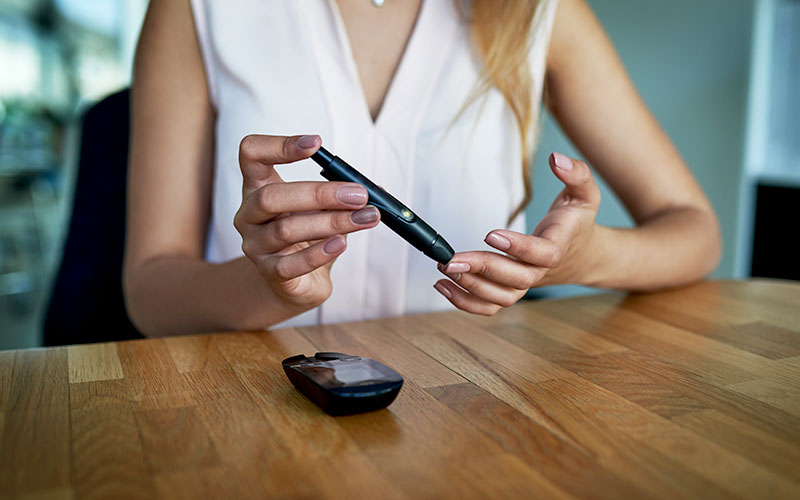The increased adoption of wearables and the expanding universe of data they create presents an opportunity for life insurers to freshen their product offerings and upgrade their customer experiences. For people living with diabetes, new treatments and technology have made the condition increasingly manageable.
Health care providers have begun using wearables to prevent diseases and maintain health.1 Real-time health monitoring systems using wearables can facilitate two-way communication between the doctor and the patient. These monitoring systems can help in early detection of underlying health conditions by extracting data around multiple parameters such as heart rate, blood pressure and body temperature. Wearables also have applications in senior care and prevention of chronic diseases. Indeed, some researchers have begun studying whether wearables can help detect the early onset of viruses including COVID-19.2
For life insurers, data from wearable devices can supplement traditional actuarial data streams that insurers collect to gauge risk and price policies.3 And insurers can leverage their deep experience working with data to identify additional ways to craft new insurance products. For clients, the wisdom derived from this data could eventually create more value by guiding them to and rewarding them for better behavior.
Early movers in life insurance for diabetics
Life insurance companies generally develop between one to three new products per year. These are usually tweaks to existing products, and details on their performance and impact is sparse. But in the past two years, Reinsurance Group of America and John Hancock Life Insurance have taken steps to extend life insurance coverage to people living with diabetes. Other life insurers are likely to follow suit.
Six of 14 insurers surveyed by RGA in 2017 said they were looking for ways to offer coverage to people with chronic conditions.4 In April, John Hancock launched its diabetes life insurance product, which it aims to pair with its tech-enabled wellness offerings to provide coverage, and guide policyholders to healthier life choices.5
In addition to these large enterprises aiming to build businesses in life insurance for diabetics, a cottage industry of consultants and brokers has developed to connect diabetics to life insurance coverage. The data shows this is a large and growing market. Some 34.2 million Americans live with diabetes, and an additional 88 million people have pre-diabetic conditions.6 In previous contexts, people with a chronic condition such as diabetes would have to pay more for life insurance, if they wanted to have the coverage.

But advances in medical technology have made chronic conditions increasingly manageable. The U.S. Centers for Disease Control and Prevention shows that life expectancy for a person with Type 2 diabetes varies greatly based on age, lifestyle and treatment.7 An insurance provider who develops the capacity to gauge the risk on those variables more keenly can uncover new potential client opportunities.
Infosys has developed a proof of concept using Infosys’s Digital Healthcare Platform to develop a differentiated life insurance product for diabetic applicants. The product uses a machine-learning algorithm trained on known diabetes data to score applicants. That allows insurers a more granular view into applicants and the ability to align policies and risk on a more customized basis.
Studying health risks associated with certain age and lifestyle can help insurance providers tap on new client opportunities
In the proof of concept, customers can set goals for activity and glucose levels. With the user’s permission, insurers can use data from wearable devices and monitors to make recommendations to better manage his or her condition. In a fashion similar to safe-driver discounts in auto insurance, the insurer can use the data to reward clients who have managed their condition well or achieve goals. In aggregate, insurers can use policyholder data to reassess the risk presented by the book of business.
Beyond diabetes to other markets
The same framework that extends insurers’ reach to people with diabetes can lead to additional market opportunities. This framework leverages data from new sources including wearables, applies artificial intelligence techniques to gauge risk and guides policyholders to better behaviors.
Insurers collect large amounts of data, but struggle to extract new insights and use them across functions. For example, analyzing data collected when bringing in new clients to find patterns, trends and correlations can become critical input for product development. Sharpening their ability to mine and harvest data from traditional sources and non-traditional sources will enable insurers to find new business and expand product offerings in this new digital era.
Applying artificial intelligence and machine learning to their growing data troves can lead insurers to develop new compelling products. AI and machine learning techniques can uncover potential gaps in product offerings and tap into under-served insurance market segments such as people with diabetes. AI can also pay a seminal role in assessing newer kinds of risks and pricing products competitively.
Figure 1. Applying the diabetes life insurance framework for next opportunities
With new data and sharper insights, insurers will be able to create win-win propositions. These products must revolve around true customer needs and engage customers in new and delightful ways. New offerings that achieve both those criteria will resonate with new customers and produce value for insurers/sup
Life insurers are looking for new lines of business. In the most recent and long-running economic expansion, life insurance didn’t keep pace with the overall economy.
Figure 2. Life insurance premiums written in OECD nations have grown slower than the economy
Source: Organisation for Economic Cooperation and Development
Businesses in adjacent industries – property and casualty insurers, health insurers, and asset managers – have added life insurance products as part of integrated offerings. For example, healthcare payer Cigna plays in the group life insurance market, and Ameriprise and Fidelity offer life and annuities products (through a mix of their own products and white-labeled products). By 2017, companies in adjacent markets had captured about 15% of the total life insurance market in 2017.8 On the other hand, life insurers have just a 4 percent share of adjacent markets. In addition, investors plowed a record $2.5 billion into disruptive insurance technology startups in 2018.9 And on July 2 amid a pandemic, tech-driven insurance startup Lemonade achieved a multi-billion-dollar valuation at its initial public offering.10
Incumbent insurers face technology-driven challenges. Wearable devices and the data they generate enable life insurers to expand their customer base, engage better with customers and freshen their product offerings.
References
- 4 Ways Wearables Are Changing the Future of Healthcare, Shubhada Khokale, eInfochips.com, October 24, 2017.
- Stanford Medicine scientists hope to use data from wearable devices to predict illness, including COVID-19, Hannae Armitage, Stanford Medicine News Center, April 14, 2020.
- Product Development: Expanding Life Insurance for Diabetics, Neill Muller, Daniel Lyons, RGA, Dec. 6, 2018.
- ‘Impaired Lives’ May Be Hot: RGA, Allison Bell, Think Advisor, Dec. 14, 2017.
- John Hancock Aspire, the First and Only Life Insurance Solution Designed for Americans Living With Diabetes, Insurance News Net, April 30, 2020.
- Statistics about diabetes, American Diabetics Association, March 22, 2018.
- Type 2 diabetes and life expectancy, Medical News Today, March 27, 2019.
- Life insurance and annuities state of the industry 2018: The growth imperative, McKinsey & Co., October 2018.
- A Record $2.5B Went to U.S. Insurance Startup Deals Last Year, Joanna Glasner, Crunchbase News, April 4, 2019.
- Lemonade logs best U.S. IPO debut of 2020 with more than 140% gain, Wallace Witkowski, Marketwatch, July 2, 2020.







